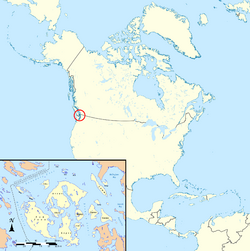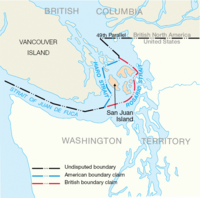British San Juan Islands
This article refers to a micronation or element of micronationalism which is defunct and no longer exists. You can help make the article reflect that or ask on the talk page for further information. |
British San Juan Islands | |
|---|---|
| Motto: Fortis et fidelis (Latin) "Strong and faithful" | |
| Anthem: God Save the King | |
 Claimed territory (white) shown in bottom left corner | |
| Status | Government in exile |
| Location | United States |
| Capital | Friday Harbor (de jure) Victoria (de facto) |
| Official languages | English Spanish |
| Religion | Secular state |
| Demonym(s) | San Juan Islander |
| Government | Federal parliamentary constitutional monarchy |
• Monarch | Charles III |
• Governor-General | Marcus Pritchard |
• Prime Minister | Lee Pritchard |
| Legislature | Parliament |
| Senate | |
| House of Commons | |
| Foundation | |
• Independence declared | 22 September 2022 |
• Disestablished | 31 May 2024 |
| Area | |
• Total | 1,610 km2 (620 sq mi) |
| Population | |
• 2022 census | 6 |
| Currency | San Juan Islands Pound (£) U.S. dollar ($) |
| Time zone | UTC−8 (PST) |
• Summer (DST) | UTC−7 (PDT) |
| Date format | mm/dd/yyyy |
| Driving side | right |
| Calling code | +1 |
| Internet TLD | .ca |
The British San Juan Islands (BSJI) were an unrecognized micronation located on the West Coast of the United States. Established in 2022 by Canadians Dustin Carlson, Marcus Pritchard and Lee Pritchard, it claimed sovereignty over the San Juan Islands which are currently part of San Juan County, Washington.
The islands were the subject of a territorial dispute between Great Britain and the United States from 1846 to 1872, resulting in the Pig War in 1859. The dispute was later settled by the Treaty of Washington which saw the islands awarded to the United States through international arbitration. The BSJI sought to terminate the aforementioned treaty and reassert "Britain's rightful claim" over the territory. Its efforts were dedicated towards establishing self-rule over the islands and achieving recognition as an independent Commonwealth realm. The government of the British San Juan Islands was not acknowledged by the United Nations or any sovereign country. Its administration was conducted from Victoria on nearby Vancouver Island in Canada and functioned as a self-proclaimed government in exile.
Etymology
The islands were named by Spanish explorer Francisco de Eliza, who charted the islands in 1791, calling them Isla y Archiepelago de San Juan. In 2022, the prefix British was added to the existing name upon the foundation of the new micronational government.
History
Background
In 1791 a Spanish expedition led by Francisco de Eliza explored the area under the authority of the Viceroy of Mexico, Juan Vicente de Güemes Padilla Horcasitas y Aguayo, 2nd Count of Revillagigedo. They charted the San Juan Islands and named many of them on Spanish navigational charts.
In 1792 the British Vancouver Expedition under the command of George Vancouver explored the region and claimed the San Juan Islands for Great Britain. After leaving the islands, the British ships met another Spanish expedition and cooperated in exploring areas farther to the north.
In 1841 the United States Exploring Expedition under Charles Wilkes explored the San Juan Islands and gave new names to many of the islands and coastal features he encountered. This led to much confusion during later exploration efforts due to differing names on numerous navigational charts. Due to this confusion, in 1847 the British Admiralty reorganized their charts of the region. Henry Kellet headed up the project and was given instructions to review names which applied only to British territory, which at the time included the San Juan Islands. Kellett ultimately kept the British and Spanish names chosen during the prior 1791 and 1792 expeditions.
Boundary dispute
Main article: Pig War (1859)

The Oregon Treaty of 1846 established the boundary between British North America and the United States along the 49th parallel and southerly through the middle of the channel that separates the continental mainland from Vancouver Island. This led to further disagreements between the two powers since there are actually two straits that can be considered the "middle" of the channel: Haro Strait (favored by the U.S.), along the west side of the San Juan Islands; and Rosario Strait (favored by Britain), along the east side. Tensions were further exacerbated by Donation Land Claim Act, enacted by the United States Congress in 1850 which led to a large migration of American settlers to the area and gradually led to conflict with British settlers already living on the islands.
On 15 June 1859, Lyman Cutlar, an American farmer living on San Juan Island shot and killed a pig he found rooting in his garden and eating his potatoes. The pig was owned by Charles Griffin, an Irish sheep farmer employed by the Hudson's Bay Company. This culminated in a heated dispute between the two men and when British authorities threatened to arrest Cutlar, American settlers on the island called for military protection. The ensuing armed build-up on both the American and British side caused a major naval standoff that nearly resulted in all-out war between the two nations. U.S. President James Buchanan sent General Winfield Scott to open negotiations with James Douglas, Governor of the Colony of Vancouver Island. The opposing sides agreed to deescalate the military standoff and maintain a joint-occupation of San Juan Island until a final resolution could be achieved.
The ongoing negotiations eventually resulted in an international arbitration, with German Emperor Wilhelm I being asked to resolve the dispute. Wilhelm ultimately settled upon the U.S. preferred boundary of Haro Strait, thus awarding sovereignty of the San Juan Islands to the United States on 21 October 1872.
Restoration effort
On 22 September 2022 the British San Juan Islands (BSJI) was formally established to "restore the native sovereignty of the islands". Carlson had prior experience with the creation and governance of micronations, being the founder and Governor-General of the Dominion of Vancouver Island. Pritchard, a citizen of the Dominion of Vancouver Island and frequent visitor to the San Juan Island National Historical Park, the location of both the British and U.S. Army camps during the Pig War, was interested in collaborating with Carlson. Together, the two men issued a press release announcing the creation of the BSJI on various social media platforms.
Politics and government
The nation was governed as a federal parliamentary constitutional monarchy. It proclaimed its allegiance to King Charles III as the country's monarch and head of state although this claim was not recognized by Charles III. It's administrative divisions consisted of five provinces and two territories. The five most populated islands, Lopez, Orcas, San Juan, Shaw and Waldron were designated as provinces while the dozens of less populated and unpoplated islands were divided into two territories - East Territory and West Territory, with the San Juan Channel acting as the internal border between the two.
The highest official within the micronation itself was the Governor-General who unofficially represented the monarch, and acted as the executive branch of government. The Prime Minister, a duly elected official, acted as the country's head of government with jurisdiction over the legislative branch. Serving at His Majesty's pleasure, the Prime Minister exercised full autonomy over domestic policies. The country's bicameral parliament consistede of a lower house, the House of Commons, and an upper house, the Senate. The British San Juan Islands claimed Friday Harbor as an official capital city, although its administration was conducted entirely from its de facto headquarters, Government House, located in Victoria, British Columbia.
Law and order
The judicial branch of government consisted of the Supreme Court, the Summary Court and the Court of Appeal. The court system was completely independent from the legislative branch of government, and handled all internal legal matters within the country. The British San Juan Islands enacted a policy that required its citizens to obey all U.S. federal, state and local laws at all times. The same rule applied to its citizens living abroad with regards to the laws of their home countries.
Geography and climate
The San Juan Islands are an archipelago consisting of over 400 islands and rocks, 128 of which are named. The total combined area of the islands is roughly 1,610 km2. Hilly terrain is found across the majority of the islands, with some scattered valleys in between. The coastlines consist of sandy and rocky beaches, shallow inlets and deep harbors. Forests of evergreen fir and pine cover vast inland areas.
The islands have a Mediterranean climate with hot dry summers and cool rainy winters.

